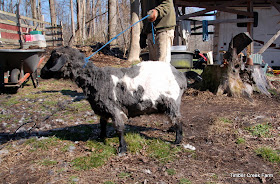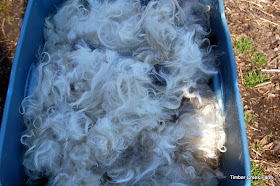I think this is our 8th year for having fiber and wool producing animals, and our 8th year of performing the twice a year shearing. Fleece producing goats need to be sheared just as sheep do, and it is quite a task. For the last three years we have also owned two sheep, so we have plenty of shearing to do. Usually, I wait until the weather is a bit more predictable. However, waiting usually means that the goats have to endure a period of time where they are hot and try to rub the fleece off by themselves. Here's the way it usually goes. The weather starts to warm up and the goats begin to rub on the fences. I notice, but, time does not permit me to get the shearing done. You ever notice how once April hits on the calendar, the weekends fill up with all kinds of things. Or the weather doesn't cooperate and the goats fiber is now matting on their bodies. Not pleasant and definitely will not yield a good fiber harvest.
 Today was a gorgeous day. The temperature was in the high 50's. The sun was shinning. A little breezy but not too windy to shear. I had recently been talking over the shearing process with a friend and was explaining to her that if you wait too long, you often get nothing worth saving. I was playing with the goats and taking some pictures and I saw the most
beautiful fleece. I thought what a shame it would be if it was all
matted and ruined before I got it harvested. When you see goats try to chew on their sides and rub the fence line, it means they are trying to remove
the itchy hot wool.
Today was a gorgeous day. The temperature was in the high 50's. The sun was shinning. A little breezy but not too windy to shear. I had recently been talking over the shearing process with a friend and was explaining to her that if you wait too long, you often get nothing worth saving. I was playing with the goats and taking some pictures and I saw the most
beautiful fleece. I thought what a shame it would be if it was all
matted and ruined before I got it harvested. When you see goats try to chew on their sides and rub the fence line, it means they are trying to remove
the itchy hot wool.
 Unfortunately, they are successful at matting and
felting the fleece while they are still wearing it. Once it is matted
and felted, it is not good for spinning and yarn making. So I took my own advice and with a bit of encouragement from my husband, we started our shearing early this year. I use a combination of my Oster Shearmaster electric shearers, and
Fiskars scissors. Goats seem especially touchy about their back leg
area so sometimes it is necessary to trim this area with the Fiskars.
This is also a great time to get the hoof trimming done.
Unfortunately, they are successful at matting and
felting the fleece while they are still wearing it. Once it is matted
and felted, it is not good for spinning and yarn making. So I took my own advice and with a bit of encouragement from my husband, we started our shearing early this year. I use a combination of my Oster Shearmaster electric shearers, and
Fiskars scissors. Goats seem especially touchy about their back leg
area so sometimes it is necessary to trim this area with the Fiskars.
This is also a great time to get the hoof trimming done.. I am glad we took this beautiful day to be outside and catch the fiber at it's best. We have not sheared this early before. I left the hair a bit long on the goats in case it gets cold again. There was still plenty to shear off. If you live in a very cold climate and want to shear while the fiber is at it's best, you can always use an old sweater as a goat coat if the animal needs extra warmth. Just cut off the sleeves and pop the front legs through the arm holes.
Baily sure looks like a giant ball of yarn in the before picture
And here she is looking trim in the after picture.
Today we were able to finish shearing four of the ten pygora goats. We gathered some of the best spring fiber ever. It is still clean, not matted, and as soft as can be. Hopefully we will be able to the other six pygoras and the two sheep done before too much longer.
 |
| Pongo |







Thanks for this post! And all your helpful information about the whole process. It's great to see photos We're hoping to get 1 finished up this afternoon. Thanks to your advice I think we'll have some spinnable fiber this year!
ReplyDeleteGretchen, I am so happy that my bits of knowledge were helpful. I received so much help from others when I was new to this. It is nice to be able to pass it on. Thank you for letting me know how things are going.
ReplyDeleteI enjoyed seeing all these photos of the goats Janet! Thank you for sharing your day with us! ~Katie
ReplyDeleteThank you for all of this great information! I have actually never seen a fiber goat before and have found I fell in love with yours! So cute and they look so incredibly soft! ~ Bobbie
ReplyDeletethanks Bobbie. They sure are cute goats and very gentle too.
ReplyDelete